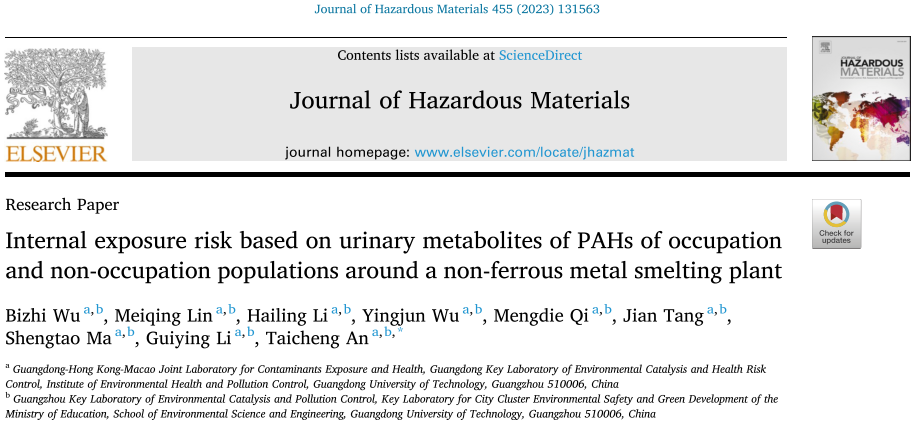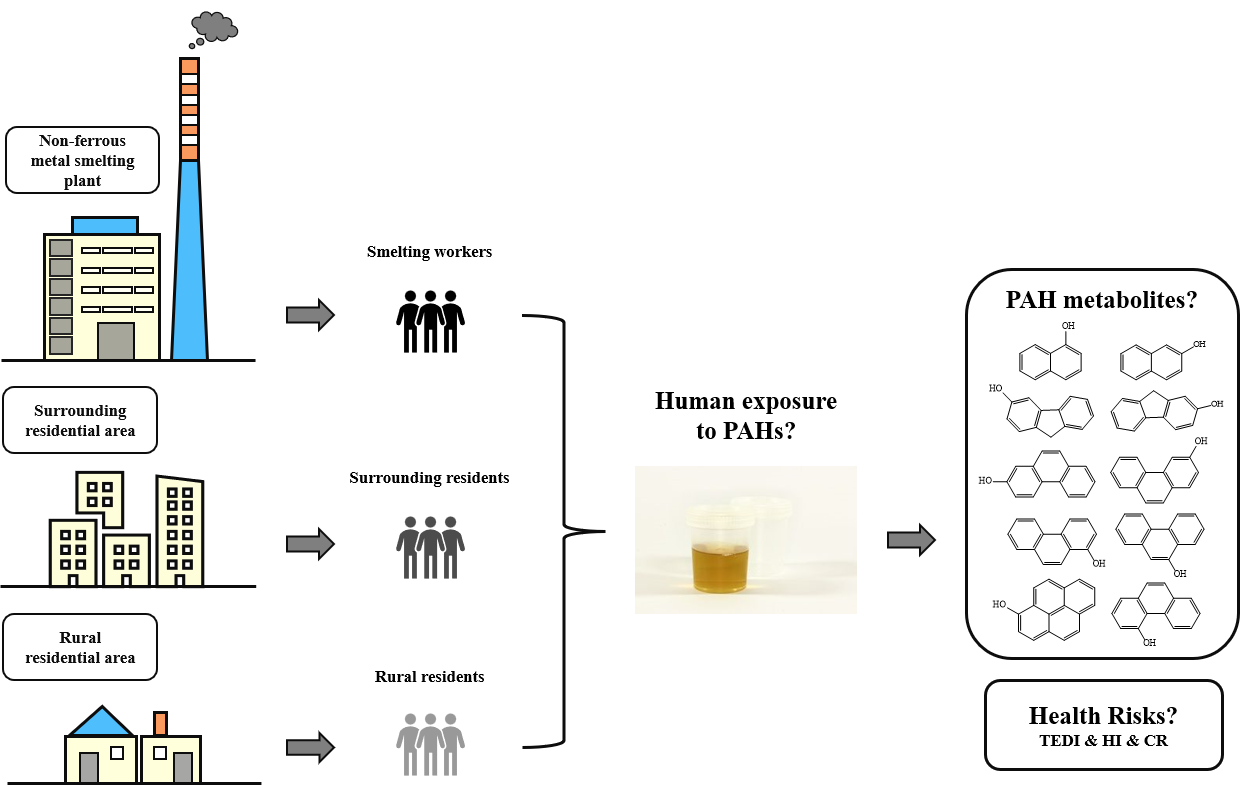近日,广东工业大学环境健康与污染控制研究院、环境科学与工程学院安太成教授团队在有色金属冶炼场地职业和非职业暴露人群多环芳烃尿液代谢产物内暴露风险方面取得最新研究进展,研究成果以《Internal exposure risk based on urinary metabolites of PAHs of occupation and non-occupation populations around a non-ferrous metal smelting plant》为题发表在Journal of Hazardous Materials (2023, 455: 131563)期刊上。论文的第一作者为硕士生吴碧芝,通讯作者为安太成教授。该工作报道了有色金属冶炼职业暴露人群和非职业暴露人群尿液样本中多环芳烃(PAHs)内暴露水平和分布特征,讨论了内暴露水平的相关影响因素及其相关性,并评估了职业暴露人群和非职业暴露人群基于内暴露水平的非致癌和致癌风险。相关研究结果为有色金属冶炼职业暴露人群的PAHs内暴露评估提供一定的基础数据。

论文网址:https://doi.org/10.1016/j.jhazmat.2023.131563
有色金属冶炼活动中排放各种金属的污染是众所周知的。然而,关于有色金属冶炼行业作业过程中排放毒害有机污染物的潜在职业暴露风险的相关研究仍然非常有限。本研究主要从从事冶炼活动的工人、居住在冶炼厂附近的居民及远离工厂的对照区居民处共收集了619份人体尿液样本,并分别测定了所有人体尿液样品中10种典型多环芳烃的单羟基代谢物(OH-PAHs)的浓度水平。研究结果发现冶炼工人的Σ10OH-PAHs中值(25.6 ng/mL)显著高于周边居民(9.00 ng/mL)和农村居民(8.17 ng/mL)(p < 0.01),表明有色金属冶炼活动具有一定的PAHs的职业暴露。三组不同人群的OH-PAH同系物组成基本相似,其中萘代谢物占总量的76–82%。同时研究还考虑了吸烟、饮酒、性别、BMI和职业类别对尿液中OH-PAHs的影响。相关性分析显示:有色金属冶炼活动对周边居民的PAH暴露影响总体不大。同时发现在健康风险评估中,几乎所有冶炼工人的癌症风险都在10–6至10–4的范围内。本研究为有色金属冶炼行业PAH的职业暴露提供了一定的数据参考,也为有色金属冶炼行业工人的健康监测奠定了一定的研究基础。
图文摘要:

英文摘要:
The emission of various metals from non-ferrous metal smelting activities is well known. However, relative investigations on potential occupational exposure of organic pollutants are still limited. Herein, total of 619 human urine samples were collected from workers engaged in smelting activities and residents living near and/or far from the smelting sites, and ten mono-hydroxylated metabolites of polycyclic aromatic hydrocarbons (OH-PAHs) in human urine were determined. The median levels of Σ10OH-PAHs in smelting workers (25.6 ng/mL) were significantly higher (p < 0.01) than that of surrounding residents (9.00 ng/mL) and rural residents as the control (8.17 ng/mL), indicating an increase in occupational PAH exposure in non-ferrous metal smelting activities. The composition profiles of OH-PAH congeners were similar in three groups, in which naphthalene metabolites accounted for 76–82% of the total. The effects of smoking, drinking, gender, BMI, and occupational categories on urinary OH-PAHs were considered. The partial correlation analysis showed an insignificant effect of non-ferrous metal smelting activities on PAH exposure for surrounding residents. In the health risk assessments, almost all smelting workers had cancer risks exceeded the acceptable level of 10−6. This study provides a reference to occupational PAH exposure and reinforce the necessary of health monitoring among smelting workers.